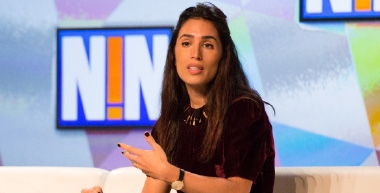Overwhelmed by cyberhate.
‘Suddenly, every stereotype, every line of attack that you ever read about or heard about in Sunday School was coming at you.’
Jonathan Weisman
Deputy Washington Editor, The New York Times
Jewish journalists on the front lines. Deluged by hate on social media.
For The New York Times political reporter Jonathan Weisman, it started with a tweet. As he had done so many times before, he read an interesting article—it happened to be about the rise of fascism in the U.S.—and tweeted it out. The first response he received had his name within triple parentheses, a symbol adopted by anti-Semites, neo-Nazis and white nationalists to identify Jews as targets for online harassment.
From there, he was hit by a tsunami of hate.
“My face superimposed on corpses in Auschwitz, pictures of my head being cut off by ISIS… At first I was so startled by it, I tweeted it back out so other people could see what was out there,” Weisman said. “People were really taken aback. I was taken aback.” The abuse was so extreme, Weisman felt compelled to leave Twitter for a time.
Sometime during the 2016 presidential campaign, it became dangerous to be a journalist.
Throughout 2016, ADL received complaints from journalists covering the campaign who were being serially harassed online merely for doing their jobs.
When online abuse has real-life consequences.
One journalist was targeted with white supremacist images embedded in a video designed to trigger his epilepsy. Many reported that they were repeatedly harassed at campaign events. This was not business as usual.
In response to this deluge of hate, ADL embarked on a groundbreaking project, convening a task force of outside experts and representatives of journalism, law enforcement, academia, Silicon Valley and nongovernment organizations. They quantified the scope of the abuse; documented how, when and where it occurred; created a profile of the abusers; and discussed solutions.
The result was the comprehensive report “Anti-Semitic Targeting of Journalists During the 2016 Presidential Campaign,” which found that anti-Semitic language on social media was shockingly pervasive. Tweets containing anti-Semitic language had an estimated potential reach of 10 billion impressions.
Empowering journalists to take on the haters.
A second ADL report, “Control-Alt-Delete,” targeted to the social media industry, lawyers and policymakers, as well as journalists, recommended solutions to the problem. For example, ADL urged platform designers to incorporate anti-harassment protections early on. We also called for new laws to criminalize certain kinds of cyberhate.
During a panel at Never is Now: The ADL Summit on Anti-Semitism in 2016, Weisman talked about his experiences with harassment on social media with Tablet Magazine writer Yair Rosenberg, who said, “They want to make us afraid. They want to unnerve us, and they want to make us withdraw from discourse.”
This outpouring of hate, ADL found, contributed to the reinforcement and normalization of anti-Semitic language on a massive scale. But ADL’s Task Force, report and recommendations empowered journalists and others to take on the haters.
Anti-Semitic harassment of journalists
ADL issued data showing the volume of anti-Semitic tweets targeting journalists on Twitter during the 2016 election campaign.












